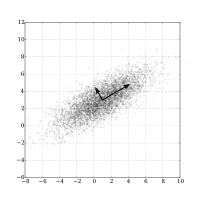
Photo from wikipedia
The measured electroencephalographic (EEG) signals used in brain–computer interface (BCI) are usually contaminated with several additive random and physiological noise components. Even though several preprocessing strategies were proposed in the… Click to show full abstract
The measured electroencephalographic (EEG) signals used in brain–computer interface (BCI) are usually contaminated with several additive random and physiological noise components. Even though several preprocessing strategies were proposed in the literature to extract useful EEG signal components for further processing and analysis, their performance is yet to meet practical needs to boost BCI applications performance. Of particular interest among those methods are the ones addressing random noise suppression that could help enhance the performance of low-cost BCI systems/headsets. A preprocessing block for signal denoising of slow cortical potential (SCP) that provides efficient noise removal and better classification accuracy is presented. This method is a variant of the spectral subtraction signal denoising whereby the noise power spectrum is estimated and removed adaptively. This method is applied to each EEG channel separately thus providing a preprocessing block that could be integrated with the existing spatial/temporal preprocessing methods. The impact of this method on classification accuracy is studied and compared to the conventional wavelet shrinkage method. The proposed method is verified using experimental data from the BCI competition II data set whereby a performance boost was obtained with the new preprocessing block. The improvement was quantitatively assessed using mean square error and mean absolute error measures and was also shown to be statistically significant. Moreover, spectral subtraction denoising is shown to have less computational complexity than wavelet shrinkage based methods. The new preprocessing block for SCP-based BCI signals based on spectral subtraction provides significant improvement in performance when added and offers an adaptive yet less computationally expensive alternative to existing methods such as wavelet shrinkage based denoising method. Also, given its independent channel processing, it shows potential for seamless integration into conventional processing chain for different BCI applications.
Journal Title: Journal of Medical and Biological Engineering
Year Published: 2018
Link to full text (if available)
Share on Social Media: Sign Up to like & get
recommendations!